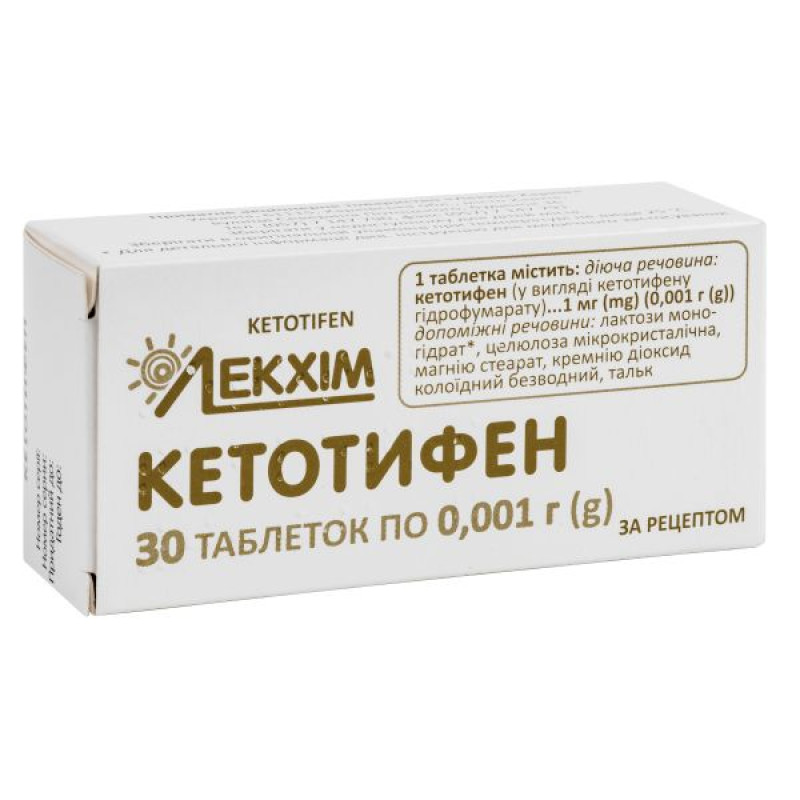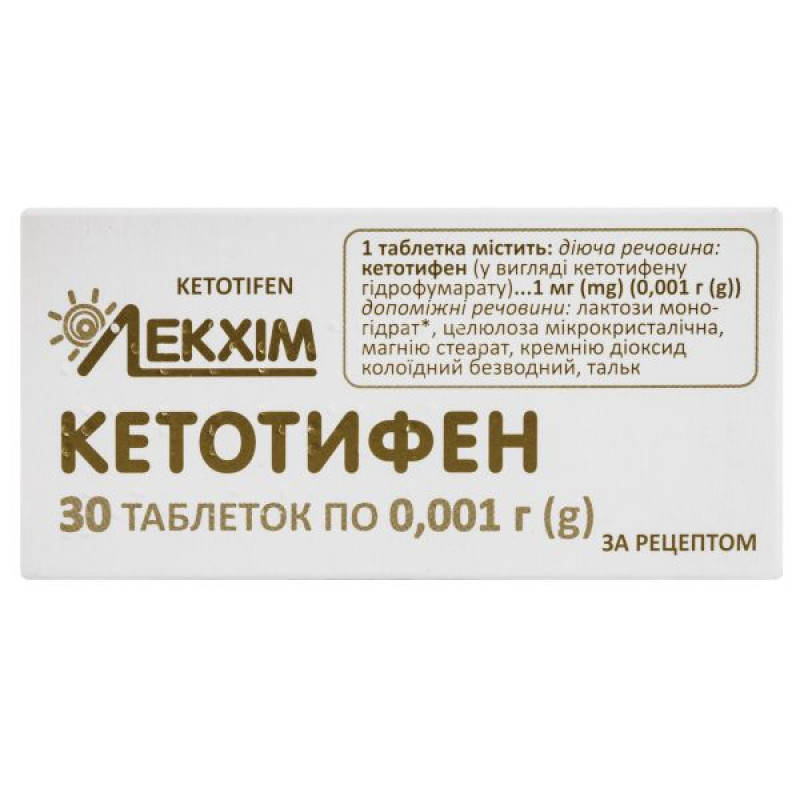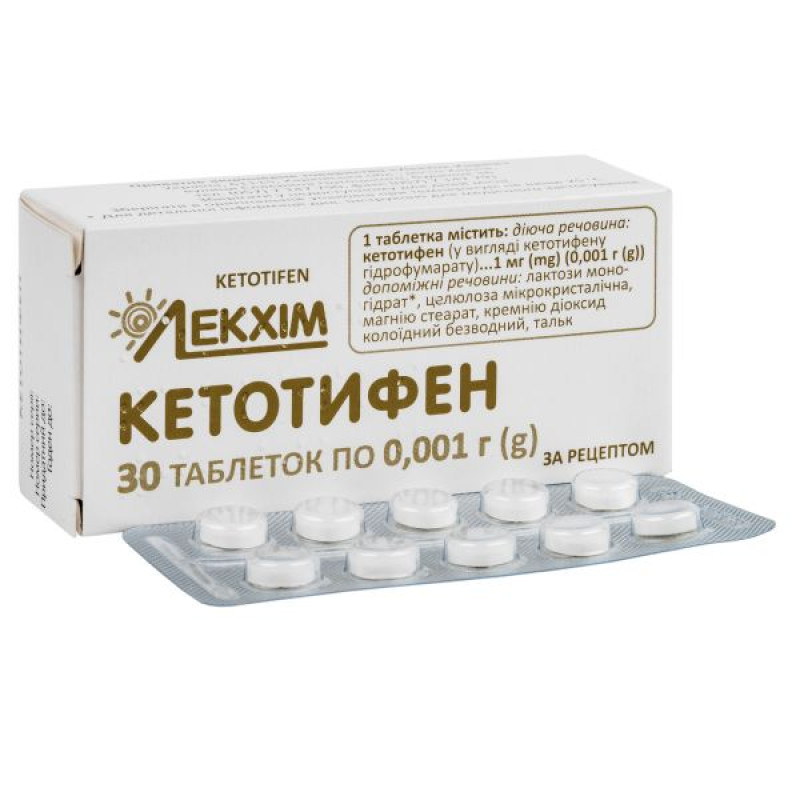Ketotifen tablets 0.001 g blister No. 30

Translation of the instructions can be
Ketotifen tablets 0.001 gInstruction
For medical use of the medicinal product
Ketotifen
(Ketotifen)
Composition:
Active ingredient: ketotifen;
1 tablet contains ketotifen (as ketotifen hydrofumarate) - 1 mg (0.001 g);
excipients: lactose, microcrystalline cellulose, magnesium stearate, colloidal anhydrous silicon dioxide, talc.
Dosage form.
Pills.
Main physicochemical properties: white or almost white tablets.
Pharmacotherapeutic group.
Antihistamines for systemic use. Ketotifen.
PBX code R06A X17.
Pharmacological properties.
Pharmacodynamics.
Ketotifen belongs to the group of cycloheptothiophenes and has a pronounced antihistamine effect. It belongs to the group of non-bronchodilating anti-asthmatic agents. The mechanism of its action is associated with inhibition of the release of histamine and other mediators by mast cells, with blocking of histamine H1 receptors and inhibition of the enzyme phosphodiesterase, as a result of which the level of cAMP in mast cells increases. Inhibits the effects of TAF (platelet-activating factor). When used alone, it does not stop attacks of bronchial asthma, but prevents their occurrence and leads to a reduction in their duration and intensity, while in some cases they disappear completely.
Pharmacokinetics.
Almost completely absorbed from the digestive tract. The maximum plasma level is reached after 2-4 hours. The equilibrium state is reached after taking the minimum daily dose, which is 2 mg. It binds to blood plasma proteins by approximately 75%. The volume of distribution is 2.7 l/kg.
About 60% of the administered dose is metabolized in the liver by three pathways (demethylation, N-oxidation, N-glucuronide) to the following metabolites: ketotifen-N-glucuronide (pharmacologically inactive), norketotifen (with pharmacological activity similar to that of unchanged ketotifen), ketotifen N-oxide and
10-hydroxyketotifen (of unknown pharmacological activity).
It is excreted biphasically, with a short half-life of 3 to 5 hours and a longer half-life of 21 hours. About 1% is excreted unchanged in the urine within 48 hours, 60-70% in the form of metabolites.
Clinical characteristics.
Indication.
Preventive treatment of bronchial asthma, especially atopic.
Symptomatic treatment of allergic conditions, including allergic rhinitis and conjunctivitis.
Contraindication.
Hypersensitivity to ketotifen or to other components of the drug.
Avoid concomitant use of ketotifen and oral antidiabetic agents (risk of reversible thrombocytopenia) until this phenomenon is sufficiently studied.
Interaction with other drugs and other types of interactions.
With the simultaneous use of ketotifen and oral antidiabetic agents, there is a risk of developing reversible thrombocytopenia, therefore this combination of drugs should be avoided.
The simultaneous use of atropine, agents with atropine-like effects and ketotifen increases the risk of side effects such as urinary retention, constipation, and dry mouth.
Ketotifen may enhance the effects of other drugs that depress the central nervous system (sedatives, hypnotics). Simultaneous use of ketotifen with other antihistamines may lead to mutual potentiation of their effects. Ethanol enhances the depressive effect of ketotifen on the central nervous system.
Application features.
The drug is ineffective in the treatment of acute allergic reactions and asthma attacks. The maximum therapeutic effect of the drug occurs after several weeks of systematic administration.
Normalization of the function of the pituitary-adrenal system may take up to 1 year. Therefore, in the first weeks of ketotifen use, it is recommended to continue the previous treatment and then cancel it gradually and for a long time.
At the beginning of long-term treatment with ketotifen, treatment with other anti-asthmatic drugs, especially corticosteroids, should not be abruptly discontinued. In patients with steroid dependence, the development of adrenocortical insufficiency may occur.
In the case of intercurrent infections, specific anti-infective therapy is necessary.
When treating with the drug, it is necessary to be under the supervision of a doctor, due to the possibility of seizures.
Ketotifen should be administered with caution to patients with a history of epilepsy due to the possibility of a decrease in the seizure threshold during treatment with the drug.
Alcohol should not be consumed during treatment with ketotifen, as it enhances the depressive effect of ketotifen on the central nervous system.
The drug should be discontinued 10-14 days before skin tests to determine allergies.
If treatment with ketotifen needs to be discontinued, the dose should be gradually reduced over 2-4 weeks to prevent the recurrence of asthma symptoms.
Caution should be exercised when administering ketotifen to patients with impaired liver function.
The drug contains lactose, so it should not be prescribed to patients with rare hereditary forms of galactose intolerance, lactase deficiency or glucose-galactose malabsorption syndrome.
Use during pregnancy or breastfeeding.
Since controlled clinical studies in pregnant women have not been conducted, the use of ketotifen is possible only when the expected benefit to the mother outweighs the potential risk to the fetus.
Ketotifen passes into breast milk, so women should stop breastfeeding if necessary to use the drug.
The ability to influence the reaction speed when driving vehicles or other mechanisms.
At the beginning of treatment, ketotifen may slow down the speed of reactions, which requires the patient to be especially careful when driving and working with automated mechanisms.
Method of administration and doses.
Take the tablets orally during meals, with water.
Dosage.
Adults: 1 tablet (1 mg) 2 times a day, morning and evening with meals. Patients who experience significant sedation during the first days of use of the drug should take Ketotifen 1 tablet per day only in the evening.
If necessary, the daily dose can be increased to 4 mg, i.e. 2 tablets 2 times a day. When using a higher dose, a faster onset of therapeutic effect can be expected.
Children from 3 years of age: 1 tablet (1 mg) 2 times a day, morning and evening, during meals.
Elderly patients: There are no special recommendations for elderly patients.
Duration of treatment.
Treatment is long-term, with the therapeutic effect being achieved after several weeks of therapy. Treatment should last at least 2-3 months, especially in patients who have not seen improvement in their well-being in the first weeks.
Concomitant bronchodilator therapy: Use of ketotifen concomitantly with bronchodilators may reduce the frequency of bronchodilator use.
Discontinuation of therapy.
Ketotifen treatment should be discontinued gradually, over 2-4 weeks, to avoid the risk of recurrence of asthmatic symptoms.
Children.
Use for children from 3 years old.
Children under 3 years of age should be prescribed the drug in a different dosage form.
Overdose.
Symptoms: significant impairment of psychomotor reactions, drowsiness to severe sedation, headache, disorientation, tachycardia, decreased blood pressure, coma (especially in children), symptoms of nervous system excitation, including convulsions, are possible.
Bradycardia, arrhythmia, respiratory center depression, and nystagmus are also observed. In the event of the above symptoms, the patient should be carefully examined.
Treatment: general measures to eliminate unabsorbed drug in the digestive tract: induce vomiting, wash the stomach. The use of activated charcoal may have a beneficial effect. If necessary, symptomatic treatment and monitoring of the cardiovascular and respiratory systems are recommended. In cases of agitation, short-acting barbiturates or benzodiazepines can be used.
Adverse reactions.
Infections and infestations: cystitis.
Immune system disorders: skin rashes, severe skin reactions, erythema multiforme, Stevens-Johnson syndrome.
Metabolic disorders: weight gain due to increased appetite.
Mental disorders: psychomotor agitation, irritability, insomnia, anxiety, nervousness, disorientation, drowsiness.
From the nervous system: dizziness, sedation, convulsions.
Gastrointestinal tract: dry mouth, stomach pain, constipation, nausea, vomiting, dyspeptic disorders.
From the hepatobiliary system: increased liver enzymes, hepatitis.
From the urinary system: dysuria.
Dry mouth and dizziness may occur at the beginning of treatment, but they usually resolve spontaneously during treatment. Symptoms of CNS stimulation such as agitation, irritability, insomnia and anxiety have been observed rarely, especially in children.
Expiration date.
5 years.
Storage conditions.
Store out of the reach of children in the original packaging at a temperature not exceeding 25 °C.
Packaging.
10 tablets in a blister, 1 or 3 blisters in a pack.
Vacation category.
According to the recipe.
Producer.
Private Joint-Stock Company "Lekhim-Kharkiv".
Location of production and its address of place of business.
Ukraine, 61115, Kharkiv region, Kharkiv city, Severyna Pototskoho street, building 36.
There are no reviews for this product.
There are no reviews for this product, be the first to leave your review.
No questions about this product, be the first and ask your question.












